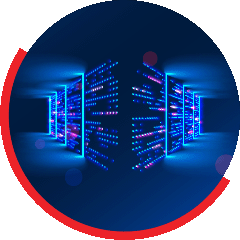
While most businesses have adopted digital infrastructure to some extent, many still lack a comprehensive plan to transform their business using appropriate digital infrastructure.
According to studies, most businesses retain legacy tools while implementing a digital strategy, resulting in a complete mismatch between digital and non-digital, resulting in subpar organizational performance. As a result, companies see satisfying results in some areas while incurring new risks and liabilities in others.
The right strategy will assist your company in transforming itself into a lean and efficient machine capable of giving your competitors a run for their money. Most importantly, having a digital strategy will allow you to better focus on your business and explore new opportunities.
5 ways to build the right digital infrastructure
Major Hardware Upgrade, If required
One of the first things you should do to assess your hardware situation is to look at your network infrastructure. Network infrastructure, which consists of both software and hardware components, is an essential component of IT infrastructure.
Your enterprise network must be of the highest quality for your software components to function properly.
Examine existing routers, operating systems, network security applications, network operations, IP addressing, wireless protocols, and other components.
Simultaneously, evaluate data centers, as most businesses use subpar services that are frequently exorbitant.
Migrate to the cloud
Today, you can practically move any legacy technology to the cloud and reap the benefits of lower costs, increased efficiency, and access to previously unavailable technology.
Software as a Service (SaaS) allows you to access and use software programmes that would otherwise be out of reach for a small business.
If you run a large company, SaaS is essential for reducing your reliance on physical infrastructure and keeping your company agile and scalable.
Pay-as-you-go models are available in SaaS models, allowing businesses of all sizes to scale or downscale based on their needs.
Furthermore, the cloud can assist you in gaining access to infrastructure via the cloud. In the Infrastructure as a Service (IaaS) model, storage, data centers, and even networks can be used. Cloud computing enables businesses to reduce organizational waste and become more lean and agile.
If you are a service provider, think about using PaaS (Platform as a Service), which allows you to develop new applications and tools on cloud-based platforms rather than having to invest in expensive platforms.
In a nutshell, cloud computing provides the technological impetus needed to propel your company forward.
Inclusions of ERP, CRM and HRMS
With more businesses utilising tools to automate processes, ERP, CRM, and HRMS tools have become almost an essential component of any successful business.
However, they create unique issues such as duplicate entries, manual information exchange, and a continuing lack of coordination between departments. Using available APIs to integrate these tools is a popular way to reduce duplicate entries and increase automation.
Most importantly, data can be shared among integrated tools, resulting in deeper insights and more accurate predictions. If you run an e-commerce business, for example, you can integrate your ERP with your CRM so that online purchases are immediately reflected in the inventory department, which can automatically replenish stocks.
The possibilities are limitless, and such a high level of coordination is only possible when software tools are integrated.
Before you decide to integrate, make sure you have an integration strategy in place and have spoken with vendors who can do it efficiently for you.
Training your employees to use the new interface effectively is also part of the integration strategy. You will also need to consider the security implications.
Internet of Things, blockchain, and artificial intelligence
These may appear to be disparate terms frequently used by IT executives, but they are critical for businesses of all sizes. The Internet of Things, or IoT, is a technology that uses sensors embedded in devices to intelligently communicate with servers and perform functions that ordinary devices cannot. These can then be linked to smartphones, giving users more control over how they interact with the device.
Blockchain is another digital technology that can be extremely beneficial to businesses. Smart contracts can be used to ensure security, and distributed ledgers can be used to process transactions safely and securely.
Blockchain has a variety of business applications, ranging from identity verification to automated approvals.
Another emerging technology that has now entered the mainstream for business use is artificial intelligence. AI-enabled chatbots can be used for customer service, social media management, and certain marketing tasks regardless of the size of your company.
These technologies are widely available, inexpensive, and simple to implement. Businesses simply need to decide whether or not to embrace them before their competitors do.
Digital governance and security
It is not enough to have the best infrastructure in place to ensure business success. The success of digital infrastructure is determined by how secure it is against various types of threats, as well as how wisely you can anticipate attacks so that you can take preventative measures.
The first step towards ensuring the security of your digital infrastructure is to conduct a risk assessment. The next step is to assess and forecast potential threats in the future. Finally, incorporating security into IT governance and digital policy is critical.
Get all decision-makers to agree on a security policy that covers the entire spectrum of digital infrastructure.
Your company is prepared for the future with the right digital strategy.
Conclusion
Leveraging digital infrastructure is more than just selecting a cloud service or deciding to integrate your ERP and CRM. It necessitates a plan and a strategy that encompasses all aspects of your company.
As you begin to assess, evaluate, and predict your needs and requirements, you will gain a better understanding of how to best implement the digital infrastructure for your company's success. Begin with a thorough audit of all your hardware and legacy tools, regardless of the size or location of your business.
Worried about getting the right digital infrastructure? We are here to help you with any technical, management, governance, assessment, migration, modernization, or optimization questions you may have.
Please contact our experts at Azurehelpdesk@sonata-software.com.
Our team will be delighted to share their solutions and ideas with you at no cost.

